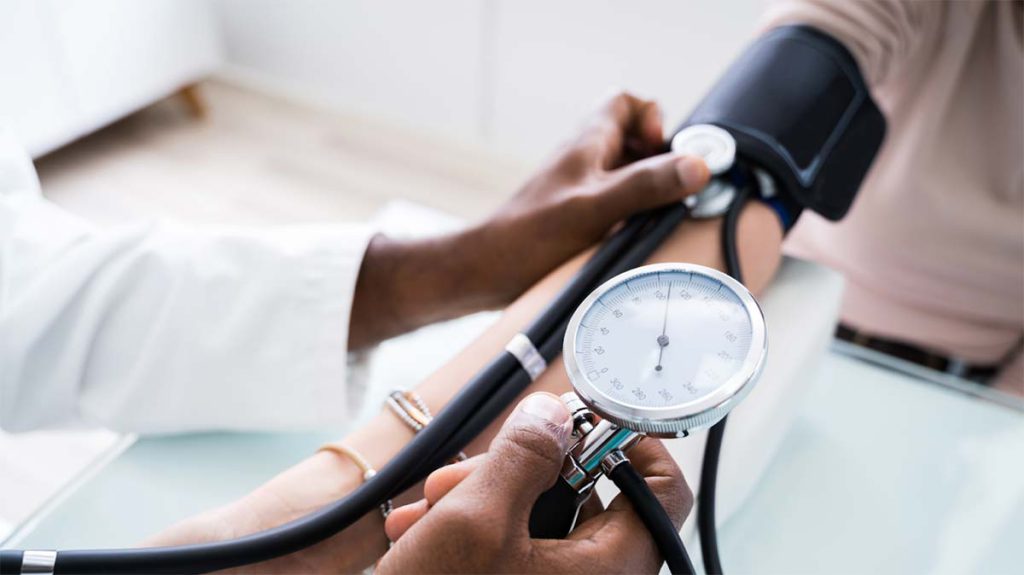Doctors refer to high blood pressure as the “silent killer” because in most cases it has no symptoms, even as it strains your heart, veins, and arteries. The condition occurs when your blood pressure is so high that the force your blood exerts as it pushes against the walls of your blood vessels actually damages your organs. High blood pressure is diagnosed by measuring two numbers: systolic blood pressure and diastolic blood pressure.
Systolic blood pressure is the force exerted on your blood vessels every time your heart beats, while diastolic blood pressure is the force exerted in between heart beats. Results are recorded in units of millimeters of mercury (mmHg), with the systolic pressure listed over the diastolic pressure ‒ 120/80, for example, which is considered normal and healthy for an average adult.
Any reading above 130/80 is considered high, but can be treated with diet and exercise. Readings above 140/90 are generally treated with medication. A systolic reading above 180 or a diastolic reading above 120 indicates the person is experiencing an acute, medical emergency known as a hypertensive crisis, and should be taken to the nearest hospital.
Dangers of High Blood Pressure
Because high blood pressure rarely causes physical distress, most patients don’t realize they’re suffering from it until they visit their doctor. But even though the condition isn’t painful, it can still cause significant damage, increasing your risk of:
- Heart Attack. High blood pressure causes your arteries to swell beyond their normal limits, harming the delicate tissue lining your blood vessels. Over time, this causes them to lose their elasticity, constricting the flow of oxygen to your heart and possibly triggering a heart attack.
- Heart Failure. Inelastic arteries restrict blood flow, forcing your heart to work harder to circulate blood. The excess strain gradually thickens the walls of your heart, a condition called vascular hypertrophy, which increases the strain on your heart until eventually it can no longer pump sufficient blood to meet your body’s needs.
- Stroke. Damage to the inner lining of your arteries creates microtears that attract plaque and cholesterol. As these deposits build up, they form blockages that reduce blood flow, increasing the risk of an ischemic stroke. The same process also makes vessels brittle, increasing the likelihood they’ll rupture and cause a hemorrhagic stroke.
- Kidney Disease. Kidneys require strong blood flow in order to function. As arteries become more constricted, your kidneys gradually lose their ability to filter blood, resulting in kidney disease and failure.
- Vision Loss. Strained blood vessels can cause your retina and optic nerve to swell. Symptoms include dark spots, blurry vision, and an inability to perceive straight lines and bright colors. If untreated, patients may become blind.
Treating High Blood Pressure
Because it does not have a singular cause, high blood pressure can be difficult to treat. While many patients improve by modifying their lifestyle (consuming less salt, red meat, alcohol, etc.), many more have to manage it through medication, due to the severity of their condition. Unfortunately, these medications often come with adverse and unwanted side effects, such as:
- Fatigue
- Muscle Cramps
- Muscle Weakness
- Cold Hands and Feet
- Coughing
- Wheezing
- Shortness of Breath
- Insomnia
- Erectile Dysfunction
- Skin Rash
- Dizziness
- Headache
- Constipation
- Fever
- Irregular Heartbeat
However, there is an alternative. Pulsed Electromagnetic Field (PEMF) therapy offers the same benefits without the physiological costs. Because our cells communicate through bioelectric currents, it’s possible to influence their behavior with low-frequency, electromagnetic waves. When applied to constricted blood vessels, PEMF helps them relax and permit more blood flow ‒ the same effect as many blood pressure medications.
The effectiveness of PEMF has been borne out by several clinical studies. One found that after 12 weeks of PEMF therapy, subjects in the treatment group showed significant reductions in their systolic and diastolic blood pressure compared to members of the control group. These findings echo an earlier study that found PEMF improved blood pressure at rest and during exercise in patients suffering from hypertension.
Patients who undergo AuraWell PEMF therapy see similar results. One, a 52-year old woman with a history of hypertension, stroke, anxiety, and depression, experienced a 13 percent decrease in blood pressure after only three months of AuraWell PEMF. Not only did she lower her risk of heart disease and stroke, her mental health also improved to the point where she no longer needed to continue her depression and anxiety medication.
Transform Your Health with AuraWell
AuraWell operates on a cellular level, literally healing you from within. Though its effects are far-reaching, the procedure is pain-free and non-invasive. Regular treatment improves your body’s ability to repair itself, lowering blood pressure and reducing discomfort while restoring joint, muscle, and nerve function. Learn more about our holistic approach by contacting an AuraWell Practitioner today!



